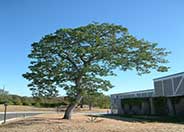
Common name:Blue Oak
Botanical name:Quercus douglasii
Blue Oak is a deciduous tree that has a slow growth rate and reaches 50 ft. high. It develops 2" long, lobed blue-green leaves. Blue Oak is very drought tolerant, is native to California and attracts butterflies. Because of its slow growth, it can be used for bonsai. Flowers are insignificant. Acorns were used by California Natives for food.

Common name:California Gray Rush
Botanical name:Juncus patens
Although a wetland plant, Juncus patens can tolerate fairly dry conditions. Eventually will clump to 2'-3' in many years. Grows to a height of 2'-2.5'. There are many selections of this species available with different foliage variations and heights. Carefree with little to no maintenance. Provides great upright structure to many styles of landscapes.

Common name:California Meadow Sedge
Botanical name:Carex pansa
This native Carex can be successfully used as a lawn substitute but requires significant water to obtain good coverage. Once coverage is reached, water can be reduced and maintenance is close to zero. Unmowed, the plant can be used effectively in a variety of conditions and will reach a height of 6" or under and spreads by rhizomes eventually to 2' +.

Common name:California Fescue
Botanical name:Festuca californica
The California fescue is a cool season bunchgrass with blue-green blades that reach 2 ft. high. The flower stalks are 5 ft. tall and create fountain-like clumps. This grass is drought tolerant for sun and shade. The California fescue is native to California and is a beneficial insect plant. -Cornflower Farms

Common name:Seaside Daisy
Botanical name:Erigeron glaucus 'Sea Breeze'
An evergreen perennial that forms clumps 6-10 inch tall by 2 feet wide with gray-green foliage and 3 inch wide lavender pink daisies with chartreuse to yellow centers from spring to fall. Plant in a location that receives full sun to light shade along the coast or light shade in warmer inland locations. Fairly drought tolerant but looks more robust with occasional irrigation. It is hardy to at least 10 F. When plants get lanky, cut back to 1 to 2 inches of stem in late fall. Tolerates coastal conditions. This cultivar was selected by Frederick Yates from a seed bed of unidentified and unpatented hybrids of Erigeron glaucus in a cultivated area of Congleton, Cheshire, England in 1992 and it received US Plant Patent PP12,076 on September 4, 2001, a patent that has since expired. Seaside daisy is native along coastal bluffs, dunes and beaches below 500 feet in the coast shrub community from the Channel Islands and mainland Santa Barbara County north to Oregon. As noted in Carol Bornstein, Dave Fross and Bart O'Brien's "California Native Plants for the Garden": Seaside daisy performs best in coastal gardens and works well in mixed borders, meadows, or containers. In richer soils, it looks better and blooms more profusely than it will in sandy or rocky soils. In inland gardens, plants in full sun flower spectacularly throughout spring but often burn to a crisp during summer … individual seaside daisy plants have a useful garden life span of two to seven years. The name for the genus comes from the Greek words 'eri' meaning early or perhaps 'erio' meaning wooly and 'geron' meaning "old man" which alludes to the bristly or wooly seed heads. The specific epithet is the Latin word (from the Green 'glaukos') meaning silvery" or "bluish-green".
Designer: Chris Dundon
Photographer: Vicki Anderson
Maintain a two to four inch layer of mulch on the soil surface to reduce weeds, infiltrate rain water, and reduce compaction.
Attract, or buy beneficial insects such as ladybugs and lacewings to control pest outbreaks in your garden.